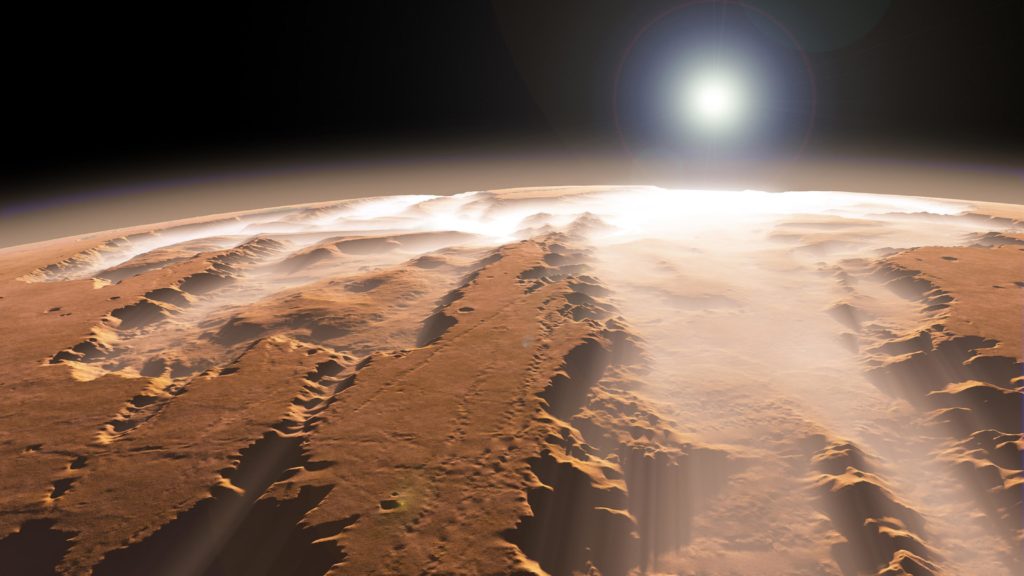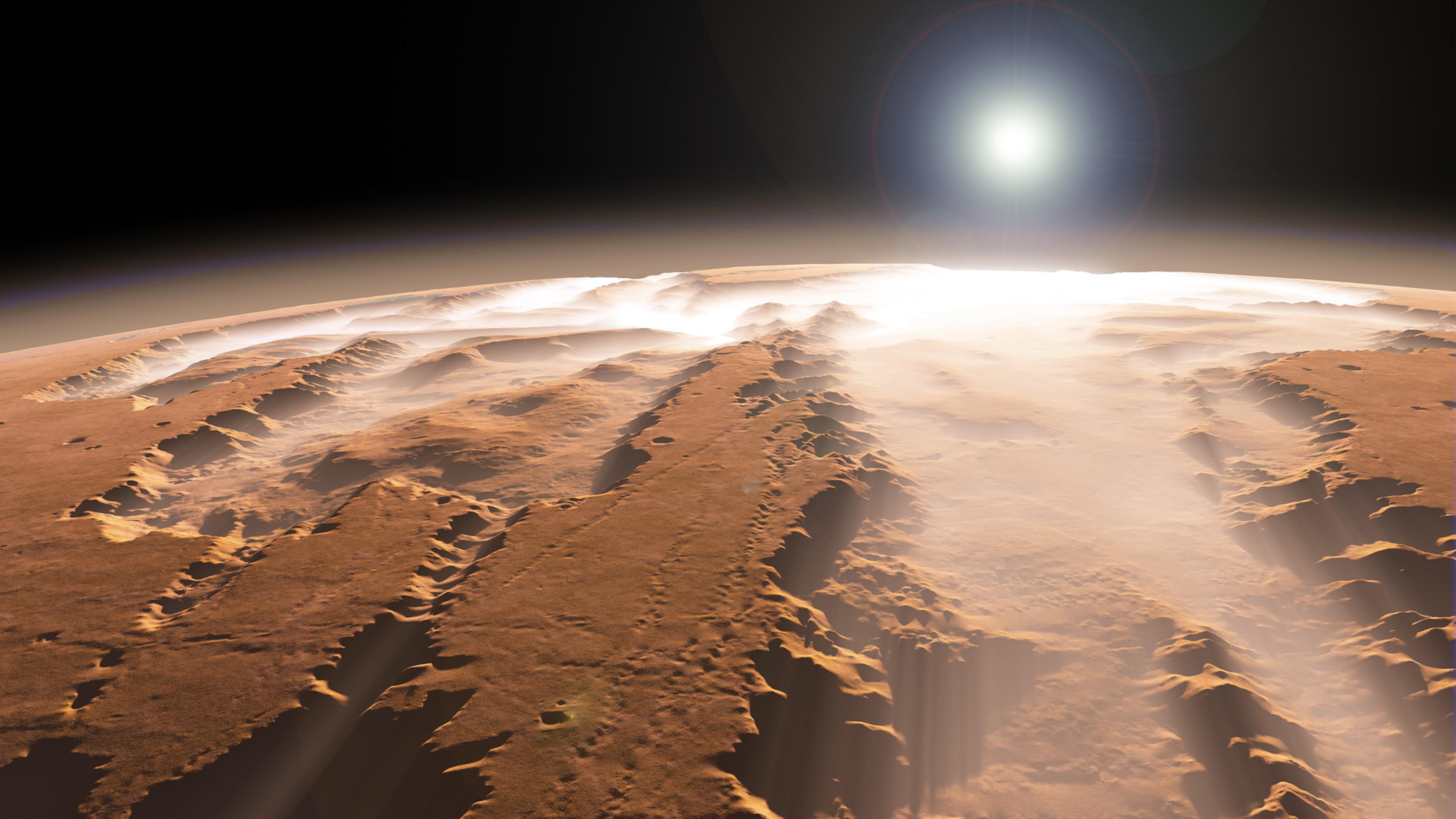Could we journey to Mars? (And should we?) – Sophie Atkinson
At Christmas I was lucky enough to visit the NASA Kennedy Space Centre and they had an exhibition there which inspired me to write this article. The exhibition was aimed at encouraging our generation to consider the possibility of travelling to Mars and getting involved with space travel. There were mirrors on the wall with things like ‘are you a future aerospace engineer’ and this experience really sparked a bigger interest in space travel for me. As well as my trip to sunny Florida the recent wave of movies released based on intrepid space adventures has peaked my interest. The Martian, Elysium, Oblivion, Interstellar and Gravity to name a few all contain (some more than others) possible future solutions to deep space travel.
So I am writing about two things; I am going to try to answer two questions: could we and should we go to Mars?
First, is it currently possible for us to go to Mars? Well in the words of Bob the Builder ‘yes we can’. I’m not saying that this kind of deep space travel is available right now but is certainly will be by the year 2030. NASA has recently passed a crucial systems test on the space launch system or SLS, the most powerful rocket ever built and this is on track to launch in 2018 for a test flight. NASA has high hopes for this rocket as it will be the first to carry astronauts past low earth orbit and into deep space. Now I am sure you all know that to get into space at all requires a lot of power… Like a rocket load of fuel and a controlled explosion. But that is just to get people to orbit the Earth, like Tim Peake is doing now. In order to get a shuttle moving through space quick enough to actually get to Mars, we are going to need a booster which packs a punch. The SLS certainly delivers this punch. It will be the most powerful rocket ever built, the fuel tank alone is 200 feet tall, and it will provide enough initial acceleration for a shuttle onboard to be able to make it to Mars in about 2 years. Over Easter NASA conducted a test on one of the four RS-25 engines belonging to the SLS. They blasted it for 500 seconds to check things like fuel consumption and everything went to plan.
Developments like this are happening in all areas of NASA, a mission to Mars is not just about the rocket; the shuttle, satellite technology, food rations, life support systems, rovers and so much more will have to be updated to make a Mars mission viable. Another notable development which is closely related to the Mars mission is the plan to use the SLS to capture and mine an asteroid in order to test the shuttle’s capabilities. Recently NASA have been granted by congress a generous budget of 19.3 billion dollars for 2016. To give a brief overview of the planned timeline… right now as Tim Peake orbits in the space station they are gathering data about protecting astronaut health in space and what life support is essential to survive long periods in space. The next step is deep space… A robot mission will capture an asteroid and bring it to orbit the moon. A manned flight will go to the asteroid and return with samples in the 2020’s. This will allow NASA to test technologies like Solar Electric Propulsion needed for a Mars mission. And then the final step, in the 2030’s humans will fly to and land on Mars.
So NASA most certainly has a plan, the funding and drive to advance our technologies until we can go to Mars or capture an asteroid.

Of course we are not there yet, there are still three main obstacles or dangers of space that need to be overcome. These dangers are space debris, radiation and microgravity. The first of which, space debris ,we tend to dismiss because we are not in the know. Well let me tell you this, space debris goes at a speed of four miles per second on average when orbiting the earth so a tiny speck of paint has the same force as a pound coin travelling at sixty miles per hour! That means that this tiny speck can punch a hole through the side of a space craft. There are in Earth’s orbit now roughly four million five hundred and twenty one thousand pieces of debris, from specks to satellites, so dodging all of this is a very dangerous game indeed. The only way to avoid this danger is making stronger, more bullet proof ships. Otherwise those on board could end up like, Sandra Bullock, spinning through space.
The next danger is radiation. Our earth’s magnetic shield protects us from 99.9% of harmful radiation yet we have all seen what a day without sun cream can do. In space we are not protected. Radiation flares, solar storms and the like are not rare in space, if a ship were to be hit it would feel like being microwaved and no you would not turn into the fantastic four… Moreover if we were to land on Mars the planet has almost no atmosphere and so protection of the landing site would be needed as well. Radiation is possibly the most tricky of the dangers as it is largely unpredictable, sudden and if strong enough could kill within minutes. The only way we could go to Mars is if the ship has some form of active or passive shielding to deflect these radioactive subatomic particles which is easier said than done. Certain particles can be deflected by magnets but we are not talking about your average bar magnet, the electromagnets needed just suck up too much power to be worth it. However the Curiosity rover has sent data on radiation during its travel to and stay on Mars, allowing scientists to begin to plan how to protect the astronauts on route to Mars.
And the last of the dangers, microgravity. It is a personal wish of mine to experience floating around in space, but have you seen Wally? This children’s film was scarily accurate when it showed the loss of muscle and bone strength due to long stretches in space. A round trip to Mars is estimated to take anywhere between three and four years, if astronauts were in microgravity for all this time their physical states may decline to such a level that they cannot perform correctly. An astronaut needs to be fit both mentally and physically so a solution for this long trip is definitely needed. Currently NASA are gathering more information about how astronauts bodies react in space from the space station. A very interesting potential idea is to create a craft that can simulate gravity by spinning. These types were shown in Elysium and The Martian, the spinning of part of the ship would create the gravity we have on earth as it simulates earths rotation which is actually about 60 miles per hour. This is the most promising idea and though difficult to engineer would work in theory, allowing astronauts like Mat Damon (who starred in both films) to keep fit in space.
So there are three things we need to do, make a stronger shuttle that can withstand debris, create a form of shielding that protects from radiation and simulate gravity in space. These are very reasonable and possible things to do, we are not talking about Star Trek warp speed or Star Wars Death Stars. These are things we can and will achieve. But we will only achieve them through the development of technologies by future generations of scientists and engineers. Which leads me onto my next question; should we go to Mars? And my firm opinion is yes we should.
Now when people ask you what you want to do and you reply that going to Mars sounds nice they look at you with a mixture of disbelief and confusion. But why would you want to go to Mars? They all say, why should we go to Mars? There are a whole host of reasons but I am only going to write about those which I think are most important.
If we had not have wanted to go to the moon then all of the technological advances that happened as a result would never have been. Space travel is the spearhead of advancing our capabilities and a good number of the developments from NASA are used in our everyday lives. It would take me years to name all of the things which space travel has improved or created but here are a few: baby milk formulas, solar panels, fire fighting gear, radios, satellite tv, artificial limbs, memory foam mattresses, cordless vacuums and the list goes on. By pushing ourselves further and aiming for what seems like an impossible goal we can further advance our everyday technologies. A lot of people think that space travel is not about planet earth, actually space travel is all about earth, about feeding back to the planet and it inhabitants new knowledge and new tech which will improve our lives. NASA is a space organisation but it has entire branches that look at our terrestrial life and closely map the globe.
The ever present issue of climate change could also be helped. The engines which rockets use now would not be so sensible to put in a car however developing hydrogen fuel engines that are slightly less explosive is a number one priority for NASA. Reducing carbon emissions through energy consumption and transportation will be improved as well. So the first reason is that by venturing further from our planet than ever before, we will be providing the knowledge and development to improve it the most. I believe that in order to get to Mars great leaps in technology and knowledge will have to be made, and this can only be a good thing. If we do not push ourselves then how can we expect to become better? Space travel is not about abandoning our planet to move to Titan, like in Oblivion, it is about saving earth.
Which brings me onto the second reason why we should go to Mars. The red planet has a geology and size mirroring our own and so could potentially allow us to unlock secrets about our own planet’s future. It is now common knowledge that billions of years ago there used to be water on Mars. No there weren’t little green men running around however over the years the rovers that have roamed on Mars have provided a lot of concrete evidence to suggest that the red planet was once a bit bluer. A recent example comes from the Opportunity rover, originally intended for a ninety sol mission she is still going strong after 4332 sols. When she landed on Mars in the eagle crater, Opportunity gathered rocks and using her microscopic imager took pictures of what are basically little blobs of iron rich minerals. These blobs are called spherules and form around groundwater. Hey presto evidence for water. As the opportunity continued her mission and travelled farther from the landing site she came upon new evidence. Just five months ago clay deposits formed by acidic water were found.
These clay deposits are a small hint to the million dollar question- was there life on Mars? Acidic water is an ideal breeding ground for microbial life, and since this clay suggests that there were rivers of this water, there could also have been microbial life. Why is discovering if there was life important? Mars is pretty much a biological battlefield, freezing temperatures, dust storms and radiation make life near impossible. So if there is or was microbial life on such a hostile planet then the possibility of life on other distant planets becomes a lot more plausible.
All of the signs are encouraging but there is no hard evidence. Which brings be back to the point that we need humans on Mars. We could send biologists, Astro biologists, botanists and geologists and they would be able to do some serious scientific graft. Humans can collect and analyse samples much better than robots and even possibly try to culture these microbes in a lab.
So for nerds everywhere going to Mars is a definite yes. NASA plan to land on Mars in 2030 that makes me only 31 years old, the prime age for space travel, it makes us the generation who must fuel this new space race and ultimately I think that in a way we can all help make it all possible. Is it not a noble aspiration to see humans on Mars, to see them living and working in truly the most hospitable environment of all because of the ingenuity and genius of humankind?
Unlike the sometimes far fetched plots of the movies I have mentioned, going to Mars is possible and I think is an aspiration for man as a whole.















Post Comment
You must be logged in to post a comment.